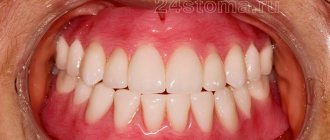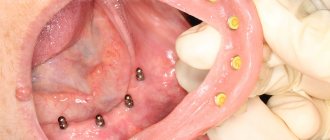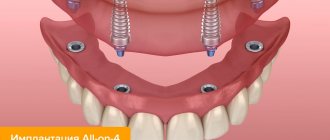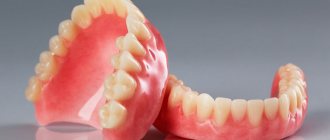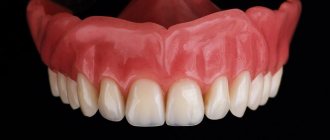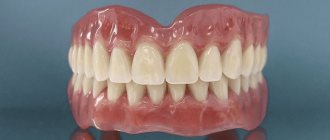Tooth loss can occur for a variety of reasons and under the influence of various factors. Sometimes a person loses several units due to injuries or dental diseases, but there are also cases of complete edentia. Restoration of dental units in the latter version can be carried out using various types of orthopedic structures, but experts recognize implant prosthetics in the complete absence of teeth as the most stable and durable method of restoration.
This procedure has significant differences with the techniques used for the loss of one or more dental units. We will get acquainted in detail with the features of the procedure, options for its implementation and prices for prosthetics on implants in the complete absence of teeth in the following sections of the article.
Calculate the cost of treatment by taking a short test in 20 seconds!
Do not delay your treatment, because in this matter time plays against us.
Complete edentia: possible options for dental prosthetics
If it so happens that the patient is missing all dental units in the oral cavity, then restoration with prosthetics on implants can be carried out using three main methods:
1. Traditional implantation. In this version of the operation, the patient is first implanted with implants, and after their integration with the tissues of the oral cavity, prosthetics is performed with fixed orthodontic structures.
2. Complete removable denture on mini-implants.
3. Conditionally removable prosthesis fixed on implants.
The second option allows you to significantly save your own budget and get excellent results from implant prosthetics at an affordable cost. Mini-implants will firmly hold the prosthesis in your mouth, and its daily use will not cause you the slightest discomfort.
Fixed prosthetics on implants is more difficult and expensive to carry out, but the patient will have the feeling of his own natural teeth in the mouth, and the design itself will be as comfortable as possible for daily use. Moreover, to implement permanent prosthetics on implants in the absence of teeth, it will be enough to implant no more than six artificial roots into the jaw bone.
Conditionally removable prosthetics are suitable for those who wanted to avoid the costs of traditional implantation and at the same time obtain an excellent and stable restoration result in the absence of teeth. Conditionally removable dentures are fixed in the oral cavity so firmly that it is impossible to remove them without the help of a specialist and, of course, they will not fall out during eating or active conversation, they do not need to be removed during the night's rest or after each meal. Below we will consider in detail the options for prosthetics on implants, taking into account the location of the treatment procedures.
Expert opinion
Roman Borisovich Alekperov
orthopedic dentist
Experience: 24 years
Although artificial gum helps distribute the load on the jawbone, this distribution is not uniform. This means that over time, atrophic dentures will inevitably develop under the removable denture, the bone will sag, the denture will become uncomfortable, no longer fit, or may even break during chewing. How to prevent the development of bone deficiency? Only with the help of implantation! If you decide to install implants after the tissue has begun to “go away,” take advantage of the possibilities of basal implantation.
Types of dental prosthetics on implants for the lower jaw
The lower jaw bone has increased thickness and density, and therefore, for prosthetics on implants in this area, a significantly smaller number of artificial dental roots are used - no more than six units. The process of osseointegration in this section of the jaw also occurs at an accelerated pace, over several months.
Removable prosthetics on implants in the complete absence of teeth in the lower jaw involves the use of two to four implants in the procedure. Most often, four implants equipped with attachments (micro-locks) are implanted into the patient. This method of prosthetics on implants in the absence of teeth has a number of advantages:
- Excellent prosthesis fixation rates;
- No need to carry out complex hygienic care procedures;
- The simplicity of the design of the prosthesis, making the price of the procedure as affordable as possible.
Partially removable dental prosthetics on two implants
When prosthetics on implants in the lower jaw area, only two artificial roots with attachments can be used: implantologists resort to this option when there is a clear deficiency of bone tissue for the installation of a larger number of implants. This method of restoration also has some disadvantages, the main of which will be the creation of pressure not only on the implants, but also on the soft tissues of the oral cavity. Such a load causes gradual atrophy of the gums, and in order to avoid such a negative phenomenon, the base of the prosthesis should be changed every six months and the strength of the attachments should also be checked.
Dental prosthetics - all-on-4 (all on four)
Another version of the prosthesis that can be used is a product with a beam-type fastening, for the installation of which in the mouth four titanium roots are first implanted - all-on-4 (all on four). This technique allows you to transfer unwanted load from the jaw to the implants and avoid the negative processes of reducing the volume of natural tissues, as well as obtain the strongest and most stable fixation of a removable denture. The orthopedic design in this case is made of polymer material, and adaptation to it occurs quickly and with a minimum of discomfort, and the prosthesis itself does not require specific care.
Dental prosthetics - all-on-6 (all on six)
Fixed prosthetics on implants is traditionally carried out using six implants, but it is also possible to carry out restoration in the area under consideration using the innovative method - all-on-6 (all on six), which involves installing two implants out of six at an angle of a certain degree. Fixed prosthetics on implants has a number of advantages, including a high level of aesthetics: a permanent prosthesis perfectly imitates natural teeth, and during the period of implant healing, the patient is given a temporary orthopedic structure (if immediate implantation was not carried out).
Implantation with screw fixation
Conditionally removable prosthetics on implants is carried out using structures fixed with screws in the area of manipulation. The denture is fixed so firmly that it can only be removed in a clinic, and this is important for patients who experience psychological discomfort from the fact that removable dentures need to be constantly removed from the mouth for hygiene, at night. Another advantage of conditionally removable prosthetics on implants is that, if necessary, the doctor can easily remove the prosthesis without damaging the structure itself, while other types of orthodontic products will be hopelessly damaged when removed - their integrity will have to be destroyed by sawing.
Prosthetics on implants in professorial dentistry “22nd century”
In the professorial dentistry, a whole staff of dentists works for you - therapists, orthopedists and implantologists, including professors, doctors and candidates of medical sciences.
Every patient who comes to the “22nd century” will be consulted by the head doctor of the clinic for free . During the visit, the optimal treatment and prosthetic plan will be selected.
In professorial dentistry, a whole staff of dentists works for you - therapists, orthopedists and implantologists, including professors, doctors and candidates of medical sciences. Our clinic is pleased to offer its patients not only an individual approach to solving the problem, but also affordable prices for services .
To make an appointment for a free appointment, just call one of the numbers listed in the header of the site.
Don't put off your visit to the dentist until tomorrow. Take a look into the “22nd century”, give yourself health and a beautiful white-toothed smile now!
Date of publication: September 20, 2020 Last update: September 22, 2022 © 2020 Professorial Dentistry “22 Century”. All rights reserved.
Upper jaw implantation
The bone in the maxillary region has a reduced density and therefore, in order to obtain the most durable fixation of the prosthesis, it is necessary to use a significantly larger number of units of implanted artificial roots - up to eight pieces. The process of integration with the tissues of the human body will also take longer – up to six months.
In removable prosthetics on implants in the absence of teeth, from four to six implants are used. A cover-type prosthesis with spherical attachments is usually fixed on four titanium roots. This type of orthopedic design will completely cover the palate, but if you want to install a prosthesis without a palate, keep in mind that it will be fixed on a significantly larger number of implanted implants, which will of course affect the final price of the procedure.
Dentures without a palate for removable prosthetics on implants in the complete absence of teeth can be fixed using micro-locks, locators, or a beam. The beam will provide maximum fastening strength, but the price of the prosthesis will be equal to the cost of a fixed orthodontic product.
Fixed prosthetics on implants in the complete absence of teeth in the upper jaw requires the preliminary implantation of six to eight implants; all-on-4 technology is also applicable to restore lost dental units. Implants are placed in the upper jaw in the traditional way, which allows you to get the most reliable, stable and durable result in permanent prosthetics on implants with complete edentia. The exact number of implants for the procedure is selected based on the condition of the bone tissue and the structural features of the jaw.
During the healing of the implants, the patient is given a prosthesis made of polymer material, which is subsequently replaced by a permanent structure made of dental ceramics or zirconium dioxide. Prosthetics on implants in the absence of teeth in the upper jaw can also be conditionally removable. In this case, implants with screw fixation in the jaw bone are used.
Advantages and disadvantages
The advantages of installing a prosthesis with soft tissue imitation include:
- increased level of aesthetics;
- protection against penetration of food debris under the crown;
- installation reliability;
- the process of restoration of chewing functions occurs faster;
- wide range of applications;
- a complex case of prosthetics in which the use of other products is impossible;
- greater comfort during installation, the use of hypoallergenic, elastic materials that do not injure the gums;
- after installing the prosthesis, you can give a full chewing load within two to three days;
- The weight of the product is small, it does not interfere with talking or eating.
There are very few disadvantages; disadvantages include the fragility of materials and dietary requirements. In addition, some Patients believe that imitation gum margin worsens the appearance, although this is not true.
Prosthetics ALL-ON-4 all on 4 (all on four)
This method of implantation was created by specialists from the implant manufacturer - the world famous dental brand Nobel. When carrying out prosthetics on implants in the complete absence of teeth, this method involves the implantation of four implants into one jaw and loading them with a fixed-type prosthesis secured with screws. Implants implanted at the end of the dentition are placed at an angle of forty-five degrees, which helps to avoid affecting complex areas during manipulation: the area where the nerve exits and the maxillary sinus.
At the development stage, the method under consideration was planned to be as gentle as possible for patients, but in order to avoid a minimum of surgical interventions, a sufficient volume of bone tissue and its solid height are required. Without meeting these conditions, it is impossible to implant an implant of the required length into the bone, and shorter structures may simply not take root. In such options, patients are offered a procedure with the installation of not four implants, but six. Two additional implants will ensure uniform load on the natural tissues of the oral cavity and significantly reduce the risk of implant rejection.
ROOTT implantation with immediate loading WITHOUT bone tissue augmentation
During ROOTT express implantation, specially designed implants are used, which eliminate the need for bone augmentation. They are fixed in the deepest layer of bone tissue (basal section), which is not subject to atrophy even after several years of missing teeth. As a result, the implants are securely attached and can withstand maximum loads for many decades. But you get a denture with a small piece of artificial gum. But you save in the following:
- the treatment period is reduced: the implants have a solid structure (the tip after installation remains above the gum level) and excellent primary stability, so immediate loading is allowed already 2-3 days after surgery. And due to the usual pressure, bone cells grow as quickly as possible around the installed implant.
- the cost of treatment is reduced: since augmentation surgery is not required, the number of treatment stages is reduced. Due to the reduction in treatment time, the cost is also reduced - when restoring completely lost teeth in two jaws, it is almost two times lower than the classical protocol,
Let us note that today artificial gums are made from modern materials and are matched in shade to the color of natural gums. As a result, the prosthesis is very thin, does not cause discomfort and is completely invisible to others.
Bone grafting: is it always mandatory?
The need for bone grafting arises when the patient has a clear lack of natural bone material - in thickness or height. If this deficiency is small, then it is possible to combine operations and carry out all manipulations simultaneously with prosthetics on implants.
If the lack of natural bone material is pronounced, then before prosthetics on implants a series of manipulations will be carried out to build up the bone material to the required volume and only then the implantation itself. In this case, the restoration process will take a considerable time and may take a year or more.
However, it will be useful to know that in modern dentistry there are techniques that allow you to avoid the mandatory bone grafting procedures before implantation. For example, the restoration of not all dental units, but only up to and including the sixth unit in the dentition of the jaw will allow not to build up the bone in height, since the implants will be placed in the area of the front teeth, in which this indicator is usually normal, as well as in the “ fives." In the future, a permanent prosthesis will be fixed to the implanted roots, and this approach will allow you to obtain an ideal implantation result in terms of aesthetics and functionality without prior bone grafting.
If the height of the bone is normal, but there is a problem with its thickness, then implants of a special design, developed specifically for such cases, can help to do without bone grafting, but in this case it is worth choosing the right artificial roots for implantation. Not all implants from all manufacturers are able to withstand high loads.
FUN FACT: The best way to avoid bone grafting is to not put off restoring your teeth. The longer dental restoration is delayed, the more the jawbone becomes thinner.
Indications for adjustments
- reduction in the volume of gingival tissue, resulting in exposure of the root tips;
- shortened teeth;
- unequal gum size;
- the presence of large gum pockets and their peeling from the surface of the dental unit;
- an inflammatory process that results in swelling and soreness of the soft tissues.
Contraindications:
- the presence of diabetes mellitus in the patient;
- period of reduced blood clotting;
- weak immunity;
- acute infectious diseases;
- cardiovascular diseases;
- patient intolerance to the anesthetic substance.
Tips for choosing the type of implants
For prosthetics on implants, products of different types and from various global manufacturers can be used. Artificial roots for implantation are available in a wide range of types and prices, but not all of the implantation systems present on the market have passed the necessary clinical trials and time-tested. In addition, not all implant options are widely used in Russia, which can lead to difficulties if it is necessary to additionally order any components for the system.
When choosing a system for prosthetics on implants in the absence of teeth, you should first consider the options offered by world-famous manufacturers and widely used in modern dentistry. When selecting implants, close attention should be paid to its connection, since the density of the artificial root in the bone and its stability and ability to withstand increased loads depend on this element.
It is also worth studying the data on the material used to manufacture implants. Research shows that the healing process of those structures that are made of pure titanium occurs faster. The more impurities are added to the production material, the longer the process of integrating the implant with the natural tissues of the human body will take. No less important is the type of surface of the implants that will be used during the restoration process.
Each brand manufacturer processes implant surfaces using its own unique technology. Special treatment of the surfaces of implants from some companies makes it possible to ensure and accelerate the process of fusion of the structure with the natural bone material of the human body, and in addition, makes it possible to use implant systems in people suffering from various pathologies of the blood and blood vessels, and autoimmune diseases.
And one more key point: even after studying all the criteria for competently choosing implants for prosthetics, do not make your own choice of system. Only a qualified implantologist can select implants and the procedure method after assessing the clinical picture of a particular case. For detailed advice from a specialist in prosthetics on implants, contact our dentistry in Moscow - Vanstom! Address of our clinic: Moscow, Baumanskaya metro station, st. Bakuninskaya, 17/28.
Calculate the cost of treatment by taking a short test in 20 seconds!
Do not delay your treatment, because in this matter time plays against us.
Manufacturing Features
Manufacturing a gingival margin product involves the following steps:
- creating an impression, determining the bite and anatomical features;
- measuring the chewing load on those areas that will act as a support;
- making drawings, preparing and fitting units;
- production of a wax structure based on a plaster model;
- creating a frame, wax impression;
- edge modeling, which is important for creating a natural look imitation of gingival and dental tissues;
- adjustment of the finished product, fitting and fixation.
The finished prosthesis should look natural, be durable and reliable. The surface imitates real vestibular texture, for which the wax melting method is used. When applying the molten mass, the required relief is provided, which makes it possible to give it an anatomically accurate shape during the manufacture of the structure. Control of the process is important, since the remaining cavities will collect food debris and become a source of spread of pathogens.
Cost of prosthetics for complete absence of teeth
The price of prosthetics with implants if all teeth are missing is not cheap, but it is fully justified by its results: aesthetics, reliability, durability. Titanium roots can serve for many years without losing useful characteristics, so all costs for prosthetics will be covered. In addition, the implantation procedure is carried out in several stages and is also paid for - payment is made separately for each stage, which makes it possible to calculate and plan upcoming costs.
The final cost of the service for the patient will be influenced by a significant number of different factors, including: the type of orthodontic product, the material of its production, the type of implant, the manufacturer of the implantation system, the method of prosthetics, the need for additional therapeutic procedures before prosthetics. Having considered all the factors in determining the price of prosthetics on implants and taking into account all the features of a specific clinical case, it is always possible to choose the implantation option that will suit the patient in terms of quality, price and result.
However, remember - the price of implantation should not be a fundamental factor if you want to receive a service of decent quality. Neither the implants themselves nor the services of an implantologist can cost a penny, since the procedure is complex and requires the use of expensive consumables and equipment. Therefore, we advise you to contact not those clinics that attract patients with low prices in their price lists, but dentists that offer fair prices for implantation. In our dentistry in Moscow, Vanstom, you can get high-quality dental services at real prices! Come to our clinic: we are located next to the Baumanskaya metro station, in the center of the capital.
Functions
Permanent dentures are impossible without an artificial component. A specially created copy of the gum makes defects completely invisible, making the structure more attractive. This form prevents the development of malocclusions, restoring the height to normal values.
Artificial gum is needed for people with a reduced size of bone fragments and a slight angle of the gum, which appeared due to a long absence of teeth. Basal renewal will make the jaw row impeccably straight. The teeth will be attached to the remaining volume of bones.
If they have been lost due to diseases such as periodontitis or periodontitis, the bone tissues lose their former strength and undergo extremely uneven changes. An artificial gum helps hide an external defect.
Comparison with the plastic method
Maxillofacial bone grafting is the latest technique in the field of dentistry, restoring chewing function to a person. Its positive difference from artificial gums is:
- Complete resumption of body activity even with an excessive amount of atrophy.
- Assumptions after the manipulation of implantation.
- Ensuring the proper level of restoration.
- Very rapid restoration of the chewing process.
In some cases, surgery is not beneficial or is completely excluded. This is due to:
- Diseases arising from pathologies of solid tissue particles, for example, osteoporosis.
- Insufficient blood clotting.
- Aggravated chronic manifestations in vital systems.
- Inflammation in the mucous membranes of the oral cavity.
- Malignant tumors at different stages of progression.
- With a very loose bone composition.
Creation
Products with artificial gum formation are produced in a dental laboratory. The process includes the following steps:
- Making a cast.
- Establishing the bite for damage, taking into account the volumetric projection of the jaw.
- Identification of pressure on organs that will serve as a support in the future.
- Planning the prosthesis.
- The procedure for grinding and adjusting teeth.
- Making a wax structure from a plaster cast.
- Formation of the frame and grinding of the workpiece.
- Taking a wax impression of the teeth.
Marginal modeling is carried out in order to achieve the greatest similarity between the interdental spaces and the natural one.
Requirements
| Click to sign up for a FREE consultation |
To give the copy the highest aesthetics, a texture reminiscent of an orange peel is imitated. To do this, liquid wax heated to high degrees is melted with a spatula. The main thing is that the modeled edge of the workpiece fills the voids. In this case, it is inappropriate to save on applying the base component, which will negatively affect the appearance and further action.
Inappropriately filled areas will retain food. The prosthesis also implies the most accurate selection of the color of the material. Modern mixtures contain high-quality components that make it possible to achieve a resemblance to the soft tissues of the oral cavity obtained from nature.
The method is widely practiced in all dental clinics in the country due to the elimination of discomfort, to obtain the correct bite and unsurpassed aesthetics.
Free consultation
Our specialists will conduct a free consultation and select the best treatment option for you.
Sign up now! Online registration
+7 (495) 649-41-19
Crowns for teeth
The ideal option for restoring one damaged tooth that cannot be filled is a crown. In this case, the dental unit is initially prepared, then an impression is made for the purpose of further recreating the crown. At the third stage, temporary prosthetics are performed. The final procedure is the installation of a permanent prosthesis.
The following crown options are available:
- Made from metal alloy. They are famous for their ideal strength and reliability indicators. However, they do not have the required aesthetics, which excludes the possibility of use in the frontal zone;
- Ceramic. They are presented by a combination of ceramic material and zirconium base. They are distinguished by precision in manufacturing, do not cause allergic reactions, can be used for a long period and have unsurpassed aesthetic parameters. The disadvantages include fragility. In addition, when such a fixed denture is installed on the lower or upper jaw, its price in mid-segment clinics is often considered overpriced;
- Made from metal ceramics. They are represented by a combination of a ceramic layer and a metal interior. They are among the most durable and durable products, which, moreover, have excellent aesthetic qualities;
- Adhesive. They play the role of a temporary structure due to the lack of sufficient strength and reliability indicators. The production is based on the use of fiberglass and photopolymer materials. This design is inexpensive and the process takes place in one visit to the dentist.
When it comes to how much it costs to install these fixed dentures, crowns made of metal and metal-ceramics are in the most advantageous position. Moreover, in order to fix them, it is not necessary to heavily prepare natural dental units. Ceramic crowns allow you to recreate the natural shade of enamel and maintain the necessary transparency. But, when choosing such new generation fixed dentures, remember that their price in Moscow remains quite high compared to other prosthetic options.
Zirconium crowns, read more > Metal-ceramic crown, read more >
| Service | Price, ₽. |
| Consultation with an orthopedist | for free |
| Orthopantomogram - panoramic image of teeth | 950 |
| Ceramic crown Dutseram plus (Germany) | 20 500 |
| Ceramic crown made of zirconium dioxide | 32 000 23 000 |
| Empress crown | 19 000 |
| Ceramic crown made of zirconium dioxide on an implant | 35 000 |
| Temporary plastic crown/wedge. | 1700/1200 |
| Taking an impression from alginate mass | 300 |
| Diagnostic plaster model | 300 |
| Taking a double impression | 800 |
| Cementing inlays and crowns using Fuji cement | 700 |
| Cementing inlays and crowns using Fuji+ cement | 800 |
| Temporary cementation of one crown | 400 |
| Removing one crown with stamped sawing | 500 |
| Removing one crown with sawing the cast | 1 000 |
| Removing one crown with sawing MK | 800 |
Features of installation of bridge structures
As stated earlier, if two or more teeth are lost, it is advisable to use bridge structures. Their production is based on the same methods and materials used in relation to other fixed prostheses. At the same time, among the best are products made from metal-ceramics and ceramics. They are presented in two versions:
- The nearby dental units serve as the base. They are distinguished by durable fastening, since they are created on the basis of impressions;
- The function of the supporting element is performed by the implant. They allow you to restore the natural beauty of your smile and restore chewing parameters in the absence of all dental units.
Fixed denture on implants
The most priority and relevant method of prosthetics in modern times is the use of implants. A clear advantage of this technique is the ability to provide the necessary load on the gums, restore chewing characteristics and restore aesthetics.
At the initial stage of implantation, a metal rod is implanted into the bone. Next, an element is installed for the correct formation of the gingival margin. After this, they proceed to the implantation of a special adapter, which is subsequently used to fix the prosthesis.
Read more >
The following materials may be used in the implant production process:
- Titanium alloy. It is considered the most popular among modern patients, due to its increased ductility and strength. In addition, this material does not darken over time and has excellent survival rate;
- Zirconium material. During the manufacturing process, a special computer program is used, which allows you to recreate the basic parameters of the tooth with maximum accuracy. It is considered a hypoallergenic material and does not cause rejection;
- Cobalt-chrome alloy. It can be used for 10 years, but does not have the required aesthetic components. Used for restoration of the chewing area;
- Metal-ceramic material. It can be used to restore frontal teeth, as it is able to convey their natural shade. It is famous for its resistance to impacts, has extreme strength and has a long service life. The only “minus” is that the mounting location may become noticeable against the general background over time;
- Porcelain. Does not change shade over time, is resistant to temperature changes, but has insufficient strength compared to the previous material.
It should be noted that when fixed dentures on implants are considered, their prices are considered the highest among all other types of prosthetics. This is due to the complexity of the work performed and the high cost of the materials used.
By contacting the Elident clinic, each patient can count on loyal prices, an individual approach to the problem and high professionalism of specialists.
| Service | Price, ₽. |
| Consultation with an orthopedist | for free |
| Orthopantomogram - panoramic image of teeth | 950 |
| Metal-ceramic crown on an implant | 18 500 |
| Ceramic crown made of zirconium oxide on an implant | 35 000 |
| Metal-ceramic crown on zirconium oxide for Straumann implant (SPECIAL!!!) | 35 000 26 500 |
| Metal-ceramic crown on zirconium oxide for implant Alpha Bio, BioLine, Osstem (SPECIAL!!!) | 35 000 25 000 |
| Temporary plastic crown/wedge. | 1700/1200 |
| Clamer spraying | 1 500 |
| Spraying the crown | 1 500 |
| Taking an impression from alginate mass | 300 |
| Diagnostic plaster model | 300 |
| Taking a double impression | 800 |
| Temporary cementation of one crown | 400 |
| Removing one crown with stamped sawing | 500 |
| Removing one crown with sawing the cast | 1 000 |
| Removing one crown with sawing MK | 800 |
| Installation of an abutment on an Alpha Bio, BioLine, Osstem implant | 6 500 |
| Installation of an abutment on a Straumann implant | 8 500 |
| Installation of a zirconium oxide abutment on a Straumann implant | 18 500 |
| Installation of abutment on zirconium oxide on an Alpha Bio, BioLine, Osstem implant | 17 000 |
Computer examination is the key to high-quality prosthetics
An accurate examination determines the success of the entire process. In our Center it is carried out using a Sirona Galileos 3D tomograph.
- study of the size and characteristics of bone tissue
- determination of implant installation positions
- calculation of the required number of implants
Price
- Primary appointment (examination, consultation) with a dentist (special offer) 100001
For free
Promotion
- SGS implant + turnkey crown
24 900 ₽
Promotion
- Osstem implant + turnkey zirconium crown
29 900 ₽
Promotion
- Astra Tech implant + turnkey zirconium crown
59 900 ₽
Promotion
- Nobel implant + turnkey zirconium crown
59 900 ₽
Promotion
- Straumann implant + turnkey zirconium crown
59 900 ₽
Promotion
- Prosthetics of all jaw teeth on 4 implants
149 900 ₽
Promotion
Implantation of the upper jaw is difficult due to the anatomy and structural features of the jaw, the location of the maxillary sinuses, and therefore requires careful planning. Loss of upper teeth leads to rapid atrophy of bone tissue; the atrophic process progresses over 2-3 months. The pronounced loss of the alveolar ridge makes reconstruction difficult in the future. Implantation of the implant restores the load on the bone and stops atrophy.
Types of fixed dentures
Recommendations for the use of various types of prostheses are made depending on the indications. Designs can be classified according to characteristics and properties: material of manufacture, purpose, price, reliability, service life.
The main types of fixed orthopedic systems include:
- crowns (single and cantilever). The design is used for partial tooth decay with mandatory preservation of the root;
- bridges. Use is indicated in case of loss of several teeth. The arch frame is fixed on the gums without covering the palate;
- veneers. Microprostheses installed on individual units to restore the aesthetics of the tooth - eliminate chips, yellowing, cracks;
- implants. The most modern technology for dental prosthetics, used for the loss of one, several or all teeth.
The most important condition for implantation is the strength of the bone tissue.
All types of dentures are securely fixed in the oral cavity; it is almost impossible to remove them yourself. The choice of a particular design is influenced by the condition of the jaw, as well as the individual characteristics of the patient.
Today, a wide range of materials are used for prosthetics in dentistry: metal ceramics, porcelain, zirconium, metal, plastic. The cost of orthopedic structures is affected not only by the material used, but also by the manufacturing technology of the prosthesis.
Complete implantation and food intake
With complete dentures, chewing efficiency is much higher. This is especially important when treating older people. After all, high-quality chewing of food has a beneficial effect on the condition of the gastrointestinal tract. And irregular eating and poor chewing can lead to various diseases. Some owners of conventional removable dentures have to eat ground food, since the denture cannot ensure the correct functioning of the jaw. Complete dentures provide adequate nutrition immediately after the adaptation period.
It is important that complete prosthetics allows you to minimize the pain that constantly occurs in those who wear a removable denture. The design of implants and prostheses does not injure the mucous membrane and does not put pressure on soft tissues.
Missing teeth is not a death sentence. With new teeth, simply having fun while eating and socializing is a completely different quality of life. The friendly atmosphere of our clinic will help you recover faster. And experienced doctors will choose the best prosthetic option and help you get your teeth back.
Full dental implants are an excellent alternative to removable dentures. Contact CELT Dentistry - we will give you back the opportunity to smile and live life to the fullest!
Restoration of chewing teeth
The doctor pays special attention to uniform distribution of the load. If it is necessary to restore 1-2 units, the classic protocol is used. If there is a lack of bone tissue, a sinus lift is performed. Implantation is possible without sinus lift using zygomatic implants, on which prostheses can be immediately fixed. But the method is used for long-term defects - from 3 teeth.
Recommendations after gum surgery
Individualization of gums during prosthetics on implants is a surgical operation with a recovery period from several days to 3-4 weeks. In the first days, swelling will persist and pain may occur, so the doctor will usually prescribe painkillers. For faster healing without complications, you will need to follow several recommendations.
It is necessary to reduce physical activity, do not eat cold, spicy and hard foods, avoid hypothermia and any mechanical damage to the oral cavity. For hygiene, you will be prescribed rinses that need to be performed regularly. In addition, you will need to wear a special mouthguard that protects the surgical site from external factors. If any disturbing symptoms appear (bleeding, pain, increased swelling), you should immediately consult a doctor.
